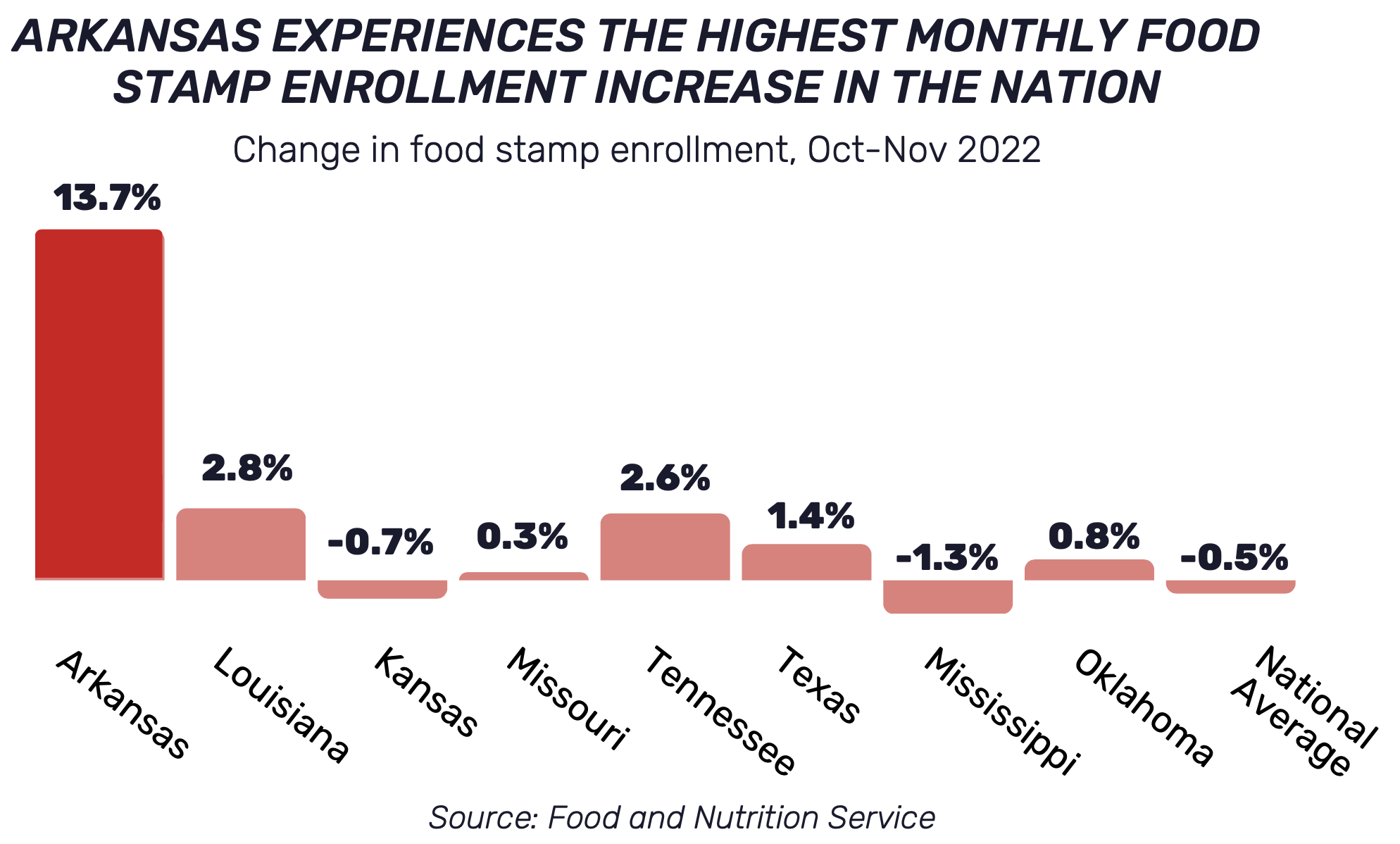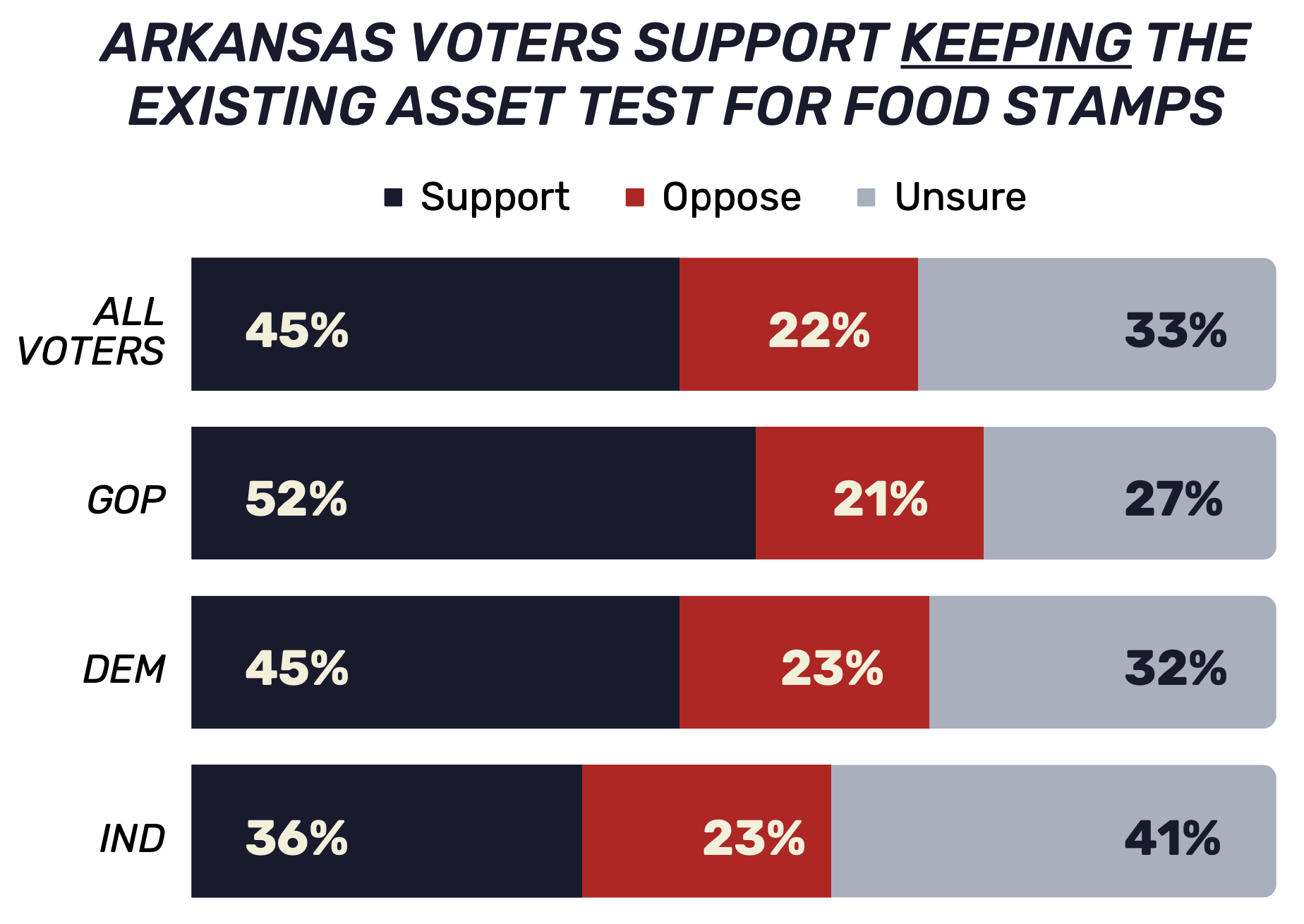1. SB306 WOULD RUIN ARKANSAS’S EXISTING STRONG ASSET TEST.
Arkansas’s current asset test for food stamps matches the federal standard.1 This asset limit is $2,750 for most households, but households with elderly or disabled residents have a higher standard of $4,250.2-3 There is already an annual cost-of-living increase review built in to the food stamps program. Additionally, several assets are exempts towards the asset limit, including:
- Homes;
- Personal goods contained in the household;
- Life insurance policies;
- Pensions; and
- At least one vehicle, with additional exemptions for certain other vehicles, such as those used for work.4
Put simply, only true liquid assets —like cash — are counted towards the food stamp asset limit. This standard ensures the safety net is focused on those who need assistance the most.5 But by expanding the cash asset limit to $12,500 — a 350+ percent increase in a single year—the program would no longer be tailored to the most vulnerable.
2. SB306 WOULD ADD UNKNOWN NUMBERS OF ARKANSANS TO WELFARE IN YEAR ONE—AND EXPAND DEPENDENCY EVERY YEAR THEREAFTER, FURTHER HARMING THE TRULY NEEDY.
By nearly quintupling the asset limit from $2,750 to $12,500, SB306 would create a massive spike in dependency in one stroke. But Arkansas taxpayers have no idea what the true effect on enrollment would be. The only thing they know for sure is that it will mean more Arkansans on welfare.
Additionally, because the asset limit will increase at the rate of inflation every single year, welfare dependency would also increase in perpetuity. Every year, more and more Arkansans would be added to this welfare program with no end in sight — siphoning resources from truly needy Arkansans who depend on the food stamp program, including many with no income and no assets.
3. ARKANSAS FOOD STAMP ENROLLMENT IS ALREADY SKYROCKETING.
According to the most recent data available from the Food and Nutrition Service which oversees the food stamp program, Arkansas’s food stamp enrollment recently jumped by nearly 14 percent, compared to a national average of declining enrollment.

4. SB306 HAS NO FISCAL IMPACT STATEMENT, HIDING ITS POTENTIALLY MASSIVE COSTS.
SB306 has no fiscal impact statement. Arkansas taxpayers have no idea how much it will cost them both in terms of increased benefits and increased administrative costs on state employees who administer the program. Additionally, the creation of new federal debt to finance this welfare expansion would be borne on the backs of future generations of Arkansans and other Americans for years to come.
5. ARKANSANS WITH $12,500 IN CASH CAN AFFORD TO BUY THEIR OWN GROCERIES, UNLIKE THE TRULY NEEDY.
$12,500 is no small sum of cash. In fact, the median American household typically has just $3,400 in their checking account, meaning they would likely qualify for food stamps under SB306.6 $12,500 in Arkansas could pay for:
- Nearly three years’ worth of groceries for a single mom and a toddler; 7
- 15 months of rent for a one-bedroom apartment in Little Rock; 8
- More than two years of child care for a four-year-old; 9
- More than a year’s worth of years tuition, fees, and books for an in-state student at Arkansas Tech University; 10 or
- Nearly 12 years worth of gas for an Arkansan driving a Ford Focus 200 miles per week at $3.05 per gallon.11
6. VOTERS OPPOSE RAISING ARKANSAS’S NATION-LEADING ASSET LIMIT.
By a more than two-to-one margin, Arkansans support keeping the current asset limit for food stamps. This includes a majority of Republicans, as well as a plurality of both Democrats and Independents.
This no surprise, as raising the asset limit would place Arkansans behind its neighbors like Kansas, Missouri, Mississippi, Tennessee and Texas—all of which would have stricter asset tests than Arkansas if this legislation were adopted. Arkansas’s asset limit is truly a model for the nation and should be protected.12

Endnotes
1. Arkansas Department of Human Services, “SNAP certification manual—sections 100 to 900,” State of Arkansas (2022), https://humanservices.arkansas.gov/wp- content/uploads/Supplemental-Nutrition-Assistance-Program-Policy-Manual4.11.22.pdf.
2. Ibid.
3. Food and Nutrition Services, “SNAP – Fiscal Year 2023 Cost-of-Living Adjustments,” U.S. Department of Agriculture (2022), https://www.fns.usda.gov/snap/fy-2023-cola. 4. Arkansas Department of Human Services, “SNAP certification manual—sections 100 to 900,” State of Arkansas (2022), https://humanservices.arkansas.gov/wp- content/uploads/Supplemental-Nutrition-Assistance-Program-Policy-Manual4.11.22.pdf.
5. Ibid.
6. Chris Moon, “Average U.S. Checking Account Balance: A Demographic Breakdown,” ValuePenguin (2022), https://www.valuepenguin.com/banking/average-checking-account- balance.
7. Food and Nutrition Services, “Official USDA Thrifty Food Plan—U.S. Average, December 2022,” U.S. Department of Agriculture (2022), https://fns- prod.azureedge.us/sites/default/files/media/file/CostofFoodDec2022Thrifty.pdf.
8. HUD, “FY2023 Little Rock-North Little Rock-Conway Fair Market Rent for One-Bedroom,” U.S. Department of Housing and Urban Development (2022), https://www.huduser.gov/portal/datasets/fmr/fmrs/FY2023_code/2023summary.odn.
9. EPI, “Child care costs in the United States,” Economic Policy Institute (2022), https://www.epi.org/child-care-costs-in-the-united-states/#/AR.
10. ATU, “Tuition and Fees,” Arkansas Tech University (2022), https://www.atu.edu/stuaccts/tuitionfees.php.
11. Calculator.me, “Fuel Budget Calculator,” Calculator.me (2023), https://calculator.me/vehicle/gas-budget.php.
12. Food and Nutrition Services, “Broad-Based Categorical Eligibility (BBCE),” U.S. Department of Agriculture (2023), https://www.fns.usda.gov/snap/broad-based-categorical-eligibility.

